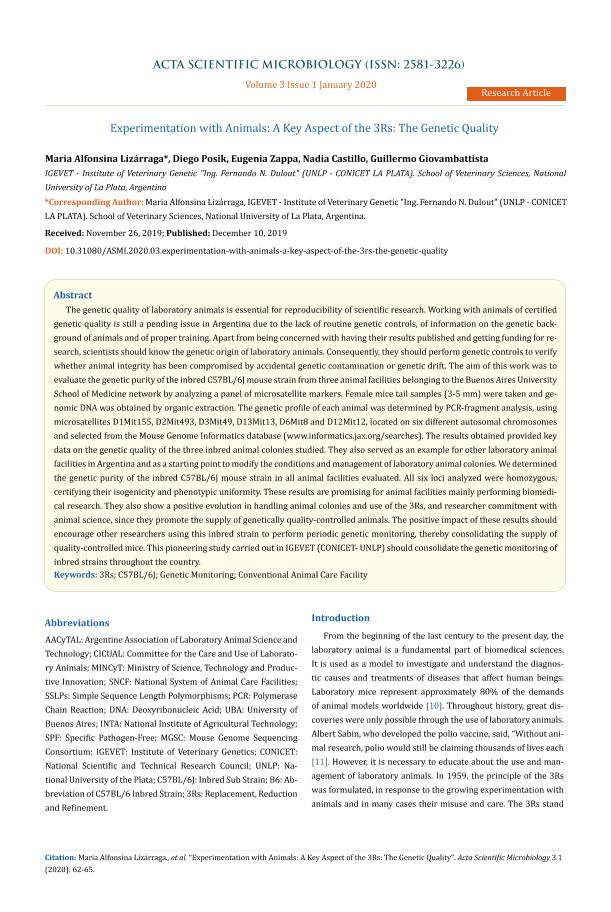Artículo
Experimentation with Animals: A Key Aspect of the 3Rs. The Genetic Quality
Lizarraga, Maria Alfonsina ; Posik, Diego Manuel
; Posik, Diego Manuel ; Zappa, María Eugenia
; Zappa, María Eugenia ; Castillo, Nadia Sabiela
; Castillo, Nadia Sabiela ; Giovambattista, Guillermo
; Giovambattista, Guillermo
 ; Posik, Diego Manuel
; Posik, Diego Manuel ; Zappa, María Eugenia
; Zappa, María Eugenia ; Castillo, Nadia Sabiela
; Castillo, Nadia Sabiela ; Giovambattista, Guillermo
; Giovambattista, Guillermo
Fecha de publicación:
02/12/2019
Editorial:
Acta Scientific
Revista:
Acta Scientific Microbiology
ISSN:
2581-3226
Idioma:
Inglés
Tipo de recurso:
Artículo publicado
Clasificación temática:
Resumen
The genetic quality of laboratory animals is essential for reproducibility of scientific research. Working with animals of certifiedgenetic quality is still a pending issue in Argentina due to the lack of routine genetic controls, of information on the genetic background of animals and of proper training. Apart from being concerned with having their results published and getting funding for research, scientists should know the genetic origin of laboratory animals. Consequently, they should perform genetic controls to verifywhether animal integrity has been compromised by accidental genetic contamination or genetic drift. The aim of this work was toevaluate the genetic purity of the inbred C57BL/6J mouse strain from three animal facilities belonging to the Buenos Aires UniversitySchool of Medicine network by analyzing a panel of microsatellite markers. Female mice tail samples (3-5 mm) were taken and genomic DNA was obtained by organic extraction. The genetic profile of each animal was determined by PCR-fragment analysis, usingmicrosatellites D1Mit155, D2Mit493, D3Mit49, D13Mit13, D6Mit8 and D12Mit12, located on six different autosomal chromosomesand selected from the Mouse Genome Informatics database (www.informatics.jax.org/searches). The results obtained provided keydata on the genetic quality of the three inbred animal colonies studied. They also served as an example for other laboratory animalfacilities in Argentina and as a starting point to modify the conditions and management of laboratory animal colonies. We determinedthe genetic purity of the inbred C57BL/6J mouse strain in all animal facilities evaluated. All six loci analyzed were homozygous,certifying their isogenicity and phenotypic uniformity. These results are promising for animal facilities mainly performing biomedical research. They also show a positive evolution in handling animal colonies and use of the 3Rs, and researcher commitment withanimal science, since they promote the supply of genetically quality-controlled animals. The positive impact of these results shouldencourage other researchers using this inbred strain to perform periodic genetic monitoring, thereby consolidating the supply ofquality-controlled mice. This pioneering study carried out in IGEVET (CONICET- UNLP) should consolidate the genetic monitoring ofinbred strains throughout the country.
Palabras clave:
3Rs
,
C57BL/6J
,
Genetic Monitoring
,
Conventional Animal Care Facility
Archivos asociados
Licencia
Identificadores
Colecciones
Articulos(IGEVET)
Articulos de INST.DE GENETICA VET ING FERNANDO NOEL DULOUT
Articulos de INST.DE GENETICA VET ING FERNANDO NOEL DULOUT
Citación
Lizarraga, Maria Alfonsina; Posik, Diego Manuel; Zappa, María Eugenia; Castillo, Nadia Sabiela; Giovambattista, Guillermo; Experimentation with Animals: A Key Aspect of the 3Rs. The Genetic Quality; Acta Scientific; Acta Scientific Microbiology; 3; 1; 2-12-2019; 62-65
Compartir
Altmétricas



